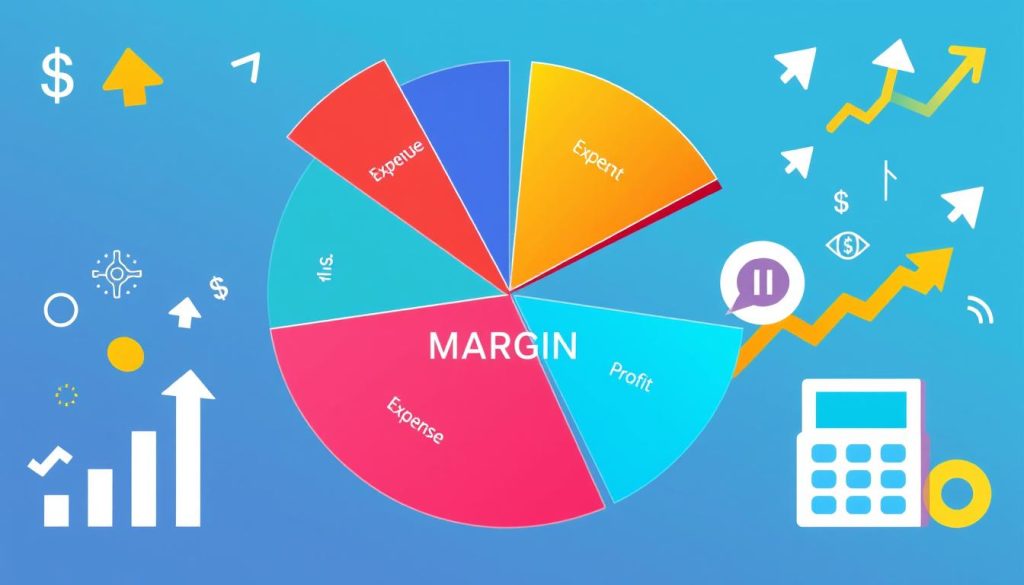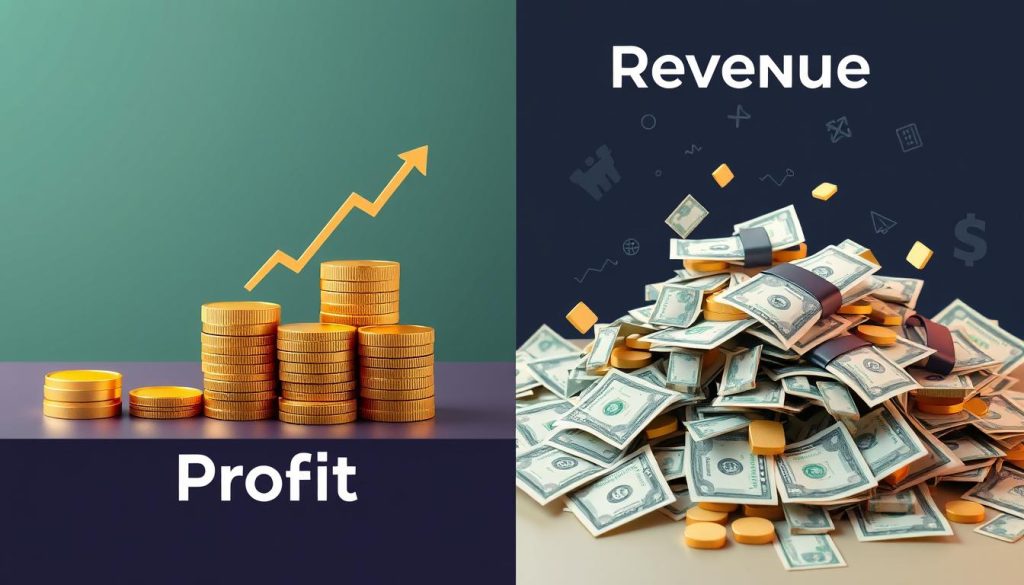Knowing the difference between gross profit vs net profit is key for businesses. It helps them make smart choices and check their financial health. Gross profit is what a company earns after subtracting the cost of goods sold from its revenue. Net profit is what’s left after all expenses, like operating costs, interest, and taxes, are taken out.
Learning about these financial metrics is vital for growth and profit increase.

By accurately figuring out gross profit and net profit, businesses can spot where to improve. They can also make better decisions on pricing, cost management, and resource allocation. Understanding how these metrics relate to each other is crucial for financial success. In this article, we’ll dive into the world of financial metrics, focusing on gross profit and net profit.
Key Takeaways
- Understanding gross profit and net profit is essential for businesses to assess their financial health.
- Gross profit is calculated by subtracting the cost of goods sold from revenue.
- Net profit is the profit left over after all expenses have been subtracted.
- Mastering financial metrics is crucial for businesses to drive growth and increase profitability.
- Accurately calculating gross profit and net profit enables businesses to make informed decisions.
- Gross profit and net profit are interrelated, and understanding their relationship is vital for businesses to optimize their financial performance.
Understanding Basic Financial Metrics
Financial metrics are key to checking how well a company does and making smart choices. At the heart of these metrics is profit, which shows how much money a business makes. Profit measurements help see how healthy a company’s finances are and where it can get better.
To really get why profit matters, we need to look at the types of profit. There’s gross profit, net profit, and operating profit. Each gives a different view of a company’s money situation. By studying these types of profit, businesses can learn a lot about their income, costs, and how profitable they are.
Read More: Weather vs Climate: Key Differences Explained
Doing a deep financial analysis is key to really understanding a company’s profit and making good choices. This means looking at financial statements like the income statement and balance sheet to spot trends. Regular financial analysis helps businesses run better, cut costs, and boost their profit margins.
By grasping these ideas and using them in their analysis, businesses can create plans for growth and betterment. This leads to more profit and success in the long run.
What Is Gross Profit?
Gross profit is a key financial metric that shows how well a company manages its costs. It’s found by subtracting the cost of goods sold from the revenue. The gross profit margin, which is gross profit divided by revenue, shows a company’s financial health and efficiency.
A company’s gross profit margin helps check its pricing and cost structure. A high margin means the company can keep prices up and control costs well. But, a low margin might show tough competition or inefficient production.
- Revenue: The total money earned from sales.
- Cost of goods sold: Direct costs for producing and selling products or services.
- Gross profit: The difference between revenue and cost of goods sold.
Understanding gross profit and margin helps companies make smart decisions. They can improve pricing, production, and cost management. This way, they can boost their revenue and keep a healthy gross profit margin.
Components of Net Profit
To grasp net profit, we must look at its parts. Net profit is found by taking away different costs from gross profit. These costs include operating expenses, interest and taxes, and non-operating expenses. Knowing these parts helps businesses make smart choices and improve their finances.
Operating expenses cover daily business costs like salaries, rent, and utilities. Interest and taxes also play a big role, affecting a company’s earnings. Non-operating expenses, however, are not directly tied to the business’s main activities, like investment losses or gains.
Also Learn: RAM vs ROM: Key Differences Explained
Key Components of Net Profit
- Operating expenses: salaries, rent, utilities
- Interest and taxes: loan interest, income taxes
- Non-operating expenses: investment losses, gains from asset sales
Understanding these parts helps businesses manage their money better. For example, cutting down on operating expenses or reducing interest and taxes can boost net profit.
Calculating Net Profit
Net profit is found by subtracting total expenses from gross profit. Here’s a simple table showing how:
| Gross Profit | Operating Expenses | Interest and Taxes | Non-Operating Expenses | Net Profit |
|---|---|---|---|---|
| $100,000 | $30,000 | $10,000 | $5,000 | $55,000 |
By studying these components and their effect on net profit, businesses can craft plans to better their financial health and reach their targets.
The Difference Between Gross Profit vs Net Profit
It’s important to know the difference between gross profit and net profit. Gross profit looks at the direct costs of making goods or services. Net profit, on the other hand, includes all expenses, giving a clearer view of profitability.
The main differences between gross profit and net profit are:
- Gross profit is found by subtracting the cost of goods sold from revenue.
- Net profit is found by subtracting all expenses, like operating costs, interest, and taxes, from revenue.
Comparing gross and net profit helps understand a company’s profitability. Here’s a table showing the difference:
| Profit Type | Calculation | Description |
|---|---|---|
| Gross Profit | Revenue – Cost of Goods Sold | Direct costs of producing goods or services |
| Net Profit | Revenue – All Expenses | All expenses, including operating expenses, interest, and taxes |
In conclusion, knowing the difference between gross profit vs. net profit is key for businesses. It helps them make better decisions about their profitability.
Calculating Gross Profit Margins
To find the gross profit margin, you need to know the formula. It’s calculated by dividing the gross profit by total revenue and then multiplying by 100. This gives you a percentage showing the margin. For example, if a company makes $100,000 in gross profit and $500,000 in total revenue, its margin is 20%. This means it keeps 20 cents for every dollar sold.
Industry standards are key in understanding gross profit margins. Each industry has its own norms. Comparing a company’s margin to these standards can reveal a lot. A higher margin than the standard might show a company is doing well. A lower margin could mean it’s facing challenges or has high costs.
Gross Profit Margin Formula
The formula for the gross profit margin is: (Gross Profit / Total Revenue) x 100. It helps compare companies in the same field. By using this formula and looking at industry standards, companies can see how they’re doing financially. This helps them make better choices to boost their profits.
Industry Standards
Gross profit margins vary by industry. Retail often has lower margins because of inventory and sales costs. Software companies, on the other hand, might have higher margins because of lower production and distribution costs. Knowing these standards helps companies set goals and measure their success.
Understanding Net Profit Calculations
To find net profit, start with total revenue and subtract all expenses. This includes operating costs, interest, taxes, and non-operating costs. The leftover amount is your net profit, showing a company’s financial health. The net profit margin is also key, showing what percentage of revenue remains after expenses.
The steps to calculate net profit are simple:
- Start with total revenue
- Subtract operating expenses
- Subtract interest and taxes
- Subtract non-operating expenses
The final result is your net profit. You can then find your net profit margin by dividing net profit by total revenue and multiplying by 100. Profit calculations like these help businesses understand their finances and make smart choices.

Understanding net profit margin and profit calculations helps businesses spot areas for improvement. This leads to better decisions and can drive long-term growth and success.
Impact on Business Decision Making
Using profit metrics is key for businesses to make smart choices. By looking at gross profit and net profit, companies can spot where to improve. They can also plan for growth by thinking about pricing and managing costs.
For example, a company might use profit metrics to figure out the best price for a product. They consider the cost of making, marketing, and selling it. This way, they can set a price that’s good for profits and still competitive.
Key Considerations for Strategic Planning
- Cost management: controlling expenses to maintain a healthy profit margin
- Pricing strategies: setting prices that balance profitability with competitiveness
- Investment decisions: allocating resources to areas that drive growth and profitability
By using profit metrics in their plans, businesses can make choices based on data. This helps them grow and stay profitable. It lets them adapt to market changes, grab new chances, and stay ahead.
In the end, profit metrics and planning are vital for business success. By focusing on these areas, companies can map out a path for growth. They can make choices that push their business forward.
| Profit Metric | Description | Importance |
|---|---|---|
| Gross Profit | Revenue minus cost of goods sold | Measures profitability of sales |
| Net Profit | Gross profit minus operating expenses and taxes | Measures overall profitability of the business |
Common Misconceptions About Profits
Understanding a company’s financial health can be tricky. Many people get confused between profit vs. revenue and cash flow vs. profit. Knowing the difference is key to making the right financial decisions.
Many think profit and revenue are the same. But they’re not. Revenue is the income from sales. Profit is what’s left after expenses and taxes. It’s important to know the difference to see if a company is really making money.
Profit vs. Revenue Confusion
- Revenue is the total income from sales
- Profit is what’s left after expenses and taxes
- Knowing the difference helps evaluate a company’s financial health
Cash Flow vs. Profit
Cash flow and profit are often mixed up. Cash flow is about money moving in or out of a company. Profit is about earnings. A company can have good cash flow but still lose money, or vice versa. It’s important to understand the difference to see if a company is financially stable.

In short, knowing the difference between profit vs. revenue and cash flow vs. profit is crucial. It helps businesses understand their financial health. This knowledge is essential for making smart financial decisions and growing the business.
| Concept | Definition |
|---|---|
| Profit | The amount of revenue left over after expenses and taxes |
| Revenue | The total income generated by sales |
| Cash Flow | The movement of money into or out of a company |
Real-World Applications
Companies like Amazon and Walmart use profit metrics to check their business profitability. They look at their gross profit and net profit to find ways to get better. This helps them boost their financial performance.
It’s important to compare profit metrics over time and across different industries. This lets companies spot trends and make smart choices. For instance, a company might compare its gross profit margin with its competitors to see how it stands in the market.
Here are some examples of companies that have boosted their financial performance by using profit metrics:
- Coca-Cola used gross profit metrics to tweak its pricing and boost sales.
- Microsoft looked at net profit metrics to see how well its products were doing. This helped them adjust their marketing plans.
By applying profit metrics in real life, companies can learn a lot about their business profitability. They can make choices based on data to grow and improve.
| Company | Gross Profit Margin | Net Profit Margin |
|---|---|---|
| Amazon | 40% | 20% |
| Walmart | 30% | 15% |
Improving Your Profit Metrics
To make your business financially healthier, focus on boosting gross profit and net profit. You can do this by setting better prices, cutting down on production costs, and making your operations more efficient.
Strategies for Increasing Gross Profit
Here are some ways to up your gross profit:
- Set prices that match the value you give to customers.
- Lower production costs by making processes smoother and talking better deals with suppliers.
- Make your products better to keep customers happy and coming back.
Methods to Enhance Net Profit
To up your net profit, work on cutting down on operating costs, managing interest and taxes, and reducing non-operating expenses. These steps can help you increase your gross profit and net profit. This leads to better financial health and more competition success.
By using these strategies and methods, businesses can boost their profit metrics. This leads to more financial stability and growth. Remember, boosting gross profit and net profit are key for lasting success in today’s market.
| Strategy | Benefits |
|---|---|
| Optimizing pricing | Increased revenue, improved customer satisfaction |
| Reducing production costs | Improved operational efficiency, increased gross profit |
| Improving product quality | Increased customer loyalty, improved brand reputation |
Conclusion
In this guide, we’ve looked at the main differences between gross profit and net profit. These two important financial metrics give us deep insights into how a business is doing. Gross profit shows the direct money made from sales. Net profit, on the other hand, includes all costs, taxes, and expenses that affect the final profit.
Knowing these profit measures is key to making smart choices and planning for growth. By looking at your gross and net profit margins, you can spot where to improve. This helps you set better prices and make changes based on data to increase profits.
Success in business means always working to improve your profit metrics. Use the tips from this article to increase your gross and net profits. Keep a close watch on these important indicators as you move through the ever-changing business world.
FAQ
What is the difference between gross profit and net profit?
Gross profit is what you get after subtracting direct costs from sales. Net profit is what you get after subtracting all costs, including indirect ones, from sales.
Why are profit measurements important for businesses?
Profit measurements show how well a business is doing financially. They help understand if a company can manage costs, set good prices, and make money over time.
How is gross profit calculated?
To find gross profit, subtract the cost of goods sold from total sales. Then, divide the gross profit by total sales to get the margin.
What are the components that make up net profit?
Net profit includes operating costs like rent and salaries, interest, taxes, and any extra expenses.
How do gross profit and net profit differ in their impact on business decision-making?
Gross profit shows how efficient a business is in making and selling products. Net profit gives a full picture of profitability, including all costs. Knowing both helps in making smart decisions about pricing, costs, investments, and planning.
What are some common misconceptions about profits?
Some people confuse profit with revenue or think high cash flow means high profit. It’s key to know the difference to truly understand a company’s financial health.
How can businesses improve their profit metrics?
To boost gross profit, focus on better pricing and cutting production costs. For net profit, manage expenses well, work more efficiently, and find new ways to make money.



